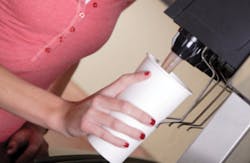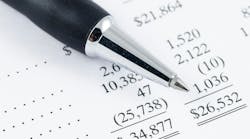Editor's note: To read part one of this article, which was originally published in the September 2013 issue of Water Technology, please visit WaterTechOnline.com.
Carbonation
When CO2 gasses off from a carbonated fountain beverage, it carries the syrup scent with it, which intensifies the aroma and also the taste. The carbonic acid, a byproduct of CO2, also gives the drink its “bite” (not the CO2 bubbles as some think). The flavor recipe of syrup is designed with acids, such as citric, to create a certain taste profile and carbonic acid is calculated into this recipe.
When water enters the carbonator, CO2 under pressure is literally forced into the water. At this point most of the CO2 is trapped by the increased pressure and intermolecular forces between the water molecules. Some molecules of CO2 react with the water to produce carbonic acid (H2CO3).
The greatest factors influencing the ability to carbonate water for beverage production will be temperature and pH. All gasses are more soluble in cold liquids versus hot. The colder the liquid, the less likely the gas will gas off from solution.
The second most important factor will be pH. Introducing CO2 into water creates a very dynamic complexity. In a carbonator, the water is in the lower region of the tank and CO2 is in the upper region. Water is sprayed into the CO2 under pressure and this drives the gas into the liquid. Some of this CO2 gas will be forced between the water molecules and some of the CO2 will convert into carbonic acid.
In its natural state, water likes to have a balance between bases and acids. The problem is, the environment of a water boost is very unnatural as CO2 is being introduced into the liquid water under pressure. If the water is high in alkalinity (high alkalinity is usually associated with high hardness, such as calcium and magnesium ions), a buffering action occurs that neutralizes the acids. It’s like taking an antacid pill, which is calcium carbonate, to neutralize excessive stomach acid. The alkalinity itself is stable, which means it doesn’t change as this buffering occurs. However, it has a large effect on the acids, which essentially convert to salts (sodium bicarbonates), as shown in Figure 1:
Figure 1
As the carbonic acid is neutralized, this leaves room for more CO2 to convert to carbonic acid. This constant back and forth interaction consumes a lot of CO2. How much is going to depend on the temperature, alkalinity, starting pH and the pressure. The higher the alkalinity, the more interaction that will occur. The net effect is a fountain beverage with poor taste and carbonation. Ideally, pH should be below 8.0 and alkalinity should be less than 150 mg/L.
Foaming, sputtering, spraying
When a dispenser sputters and sprays, it can lead to dry cleaning for the customer, loss of revenue and service calls. There are a number of reasons that this occurs.
If the ice on the cold plate melts too quickly, it could cause an “ice bridge” to form on the cold plate. This can create warm pockets and prevent the ice from coming into direct contact with the cold plate, raising the temperature. If the temperature of the fountain drink rises to 40° F or higher, the drink will not be properly carbonated and there will be foaming. When the temperature of the drink reaches 50° F, nearly a quarter of the carbonation will have been lost. Fast melting ice can be caused by ice that’s been made with poor quality water, such as high Total Dissolved Solids (TDS). I’ll cover this in more detail in part three of this article.
Foaming and sputtering can also be caused by air in the beverage lines. Every BIB has a bubble of air in it (about the size of a grapefruit in volume). When the BIB goes into sold out (empties), the air is evacuated into the BIB pump and pushed into the beverage line. Dispensing valves are designed to compensate for these small amounts of air. However, sometimes too much air is drawn into the beverage lines. This can cause pressurized syrup to spit and spray at the dispenser, create foaming and result in drinks with too little syrup.
There are devices that can remove air from beverage lines, such as the Airvent. The Airvent has a mixing chamber that draws air out and expels it through a gas permeable membrane.
Flow
Water and syrup should flow at a rate between 1.25-3.8 oz./sec, depending on the type of valve (standard valves are 3 oz./sec) and how the flow rate is set in the valve. If the water is high in particulate, the flow can be disrupted. For example, inside a valve head there’s a solenoid and pressure compensating flow controls that control the flow of water and syrup. The paddles can get stuck due to particle accumulation, iron slime or sugars that have crystalized. These can restrict the flow and obstruct the sealing surface of the solenoid valve, resulting in a loss of flow, incorrect brix ratios or leaking valves. A valve stuck open will run continuously. The diffuser in the valve head can also become plugged with dirt.
Pressure
The water supply to fountain equipment must provide a dynamic pressure greater than 50 psi. If the water pressure is too high (>70 psi) it can exceed the CO2 pressure and the water won’t carbonate. If the water pressure is too low (<20 psi), the carbonator tank will not fill properly. Non-carb dispenser valves also have a minimum/maximum operating pressure. If the water pressure is too low it will result in a ratio of too much syrup. This costs the foodservice operator money and can change the profile of the beverage which some consumers may not appreciate. If the water pressure is too high it can flood the carbonator, resulting in no carbonation and it can cause the valves to leak.
A water boost system elevates the pressure to 90 psi and stores the water under pressure in an accumulator tank. This ensures that there is enough pressurized water for all the components in the beverage system during peak operating hours when the water pressure in the restaurant is likely to fluctuate.
Water Pressure Reducing Valves (WPRV) are devices that are set to specific psi levels, with pressure ranges from 30 to 80 psi. The WPRV should be installed as close as possible to the inlet of the carbonator pump and dispenser.
Non-Carbonated Water Circuit Example:
Without Boost With Boost
City Water Supply ………………………… 50 psi 90 psi
Water Filtration Avg. pressure drop…… (12 psi drop) (12 psi drop)
Subtotal ……………………………………….. 38 psi 78 psi
Pressure Drop through water lines two valves. (20 psi drop) (20 psi drop)
Subtotal………………………………………. 18 psi 58 psi
Pressure drop through thru cold plate two valves. (16 psi drop) (16 psi drop)
Available pressure to dispense valves. 2 psi 42 psi
Water filtration systems have minimum water pressure requirements. Keep in mind that if water pressure is too low, the filters will plug prematurely because the particulate will collect only on the surface of the carbon and will essentially “cake” itself, instead of penetrating deep into the cartridge.
Always put a carbon water filtration system after the water boost. This keeps:
- High water pressure flowing to the filter system, which extends the life of the cartridges
- The chlorine in the bladder of the water boost to prevent growth of algae and bacteria.
Sometimes a prefilter is placed upstream from the water boost to help protect a water boost rotary pump from abrasion that could damage it. One risk of this though is that if the prefilter plugs from dirt, it could starve the pump of water, damaging the pump. Whether the water boost uses a diaphragm or a rotary vane pump, the prefilter should be placed after the water boost.
The ideal water specification for fountain beverage:
- Turbidity: Must not exceed 0.5 Nephelometric Turbidity Units (NTU)
- Taste/Odor: Free from off-tastes and odors
- Total Chlorine: <0.05 ppm
- Total Alkalinity: Not more than 150 mg/L
- Total Hardness: Not more than 100 mg/L
- Total Dissolved Solids (TDS): Not more than 500 mg/L
- Chlorides: Not more than 250 mg/L
- pH: 6.5 to 8.5
- Iron: Not more than 0.25 ppm.
Water treatment for fountain beverages
When sizing a filtration system, determine the flow rate required by looking for the number of carbonators, but do not count the non-carb booster pump:
|
1 Carbonator = 1.67 gpm |
|
2 Carbonators = 2.51 gpm |
|
3 Carbonators = 3.34 gpm |
|
4 Carbonators = 4.18 gpm |
For non-carb, add an additional 1.67 gpm to the carbonator flow rate.
Using a standard 5:1 water to syrup ratio, one five gallon BIB = 25 gallons of water. So to determine the capacity requirements of a filter system, multiply the number of BIBs emptied per day times five gallons. For example, if the customer uses five BIB per day, that’s 125 gallons of water per day, or 45,625 gallons per year (assuming the location operates 365 days per year).
Because fountain beverages are a significant source of revenue, consumers can find their favorite carbonated and non-carbonated beverages in most restaurants and convenience stores. However, if a fountain drink is flat, tastes poorly or the customer gets spattered with syrup at the dispenser, it could be a lost customer and lost future revenue. A good water filtration system can ensure quality and consistency and is affordable: The cost per gallon, including both the cost to purchase the system and the cost of replacing filters, can be less than $0.02 per gallon.
If the beverage system is owned by the customer, they should look for a filter system that:
- Has the flow rate to keep up with the fountain dispenser(s) and the capacity to last six months or 12 months, depending on the change cycle preferred.
- Is designed for the water contaminants that need to be removed. For example, if the customer’s water is high in particulate, it might be necessary to move from submicron to 5 micron filtration and add a prefilter.
- Fits in the space available. If the filter system needs to be placed under a counter or behind a dispenser be sure it will fit and still give easy access for replacing the filter cartridges.
- NSF certification of Standard 42 (aesthetics) and/or 53 (health effects). This third party certification helps to ensure you are getting what you paid for.
If the beverage equipment came from the syrup provider, have the foodservice operator ask them about the water filtration options offered. For filter systems already installed, it’s best to change the filters on a regular schedule to ensure consistency and to avoid a plugged filter during peak traffic. Keep in mind that if the filter system was installed years ago, the water requirements may have increased as new beverage equipment has been added so the current filtration system may not be keeping up with current demands. Also, the local municipality may have recently switched from chlorine to chloramine disinfection, requiring a system upgrade to a system that can remove chloramines. Finally, don’t forget the role that water pressure plays in keeping the beverage system and the filter system operating at peak performance.
Next month, I’ll provide information on how water impacts ice quality and ice machines.
Roy Parker is the global senior marketing manager for the foodservice vertical of Pentair, which includes the product lines Everpure® and Shurflo®. He’s been with Pentair for seven years and is based at the foodservice World Headquarters in Hanover Park, Illinois. He can be reached at [email protected]. Pentair Everpure is celebrating 80 years and Pentair Shurflo is celebrating 45 years of providing innovative water treatment and beverage system solutions for foodservice operations around the world.


